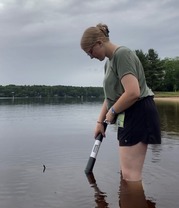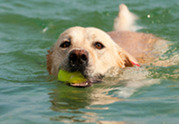 The Dog Days of Summer (Literally)!
This message is being sent to local public health officers, Tribal health directors, the Harmful Algal Blooms list, and key DPH staff.
With the hot, humid days of summer approaching, it is important be on alert for unsafe water conditions like harmful algal blooms (HABs). The “dog days of summer” are a good reminder that humans aren’t the only ones who can get sick from exposure to HABs. Our beloved furry friends can also become ill after ingesting or coming into contact with a bloom and will often experience more severe symptoms than humans.
This issue will provide more insight about HAB-related animal illnesses in Wisconsin. It will also highlight major HAB Program updates, what local health departments have been doing to prep for the HABs season, and information regarding cyanotoxins in dietary supplements and food ingredients.
Program updates
HABs and fish fact sheet
A new fact sheet created by the DHS HAB Program offers research-based health guidance for safe fishing practices and consumption of fish in HAB-affected waters. The target audience for this fact sheet are recreational and occupational anglers, and populations who consume fish.
Signage translations
The HAB Program recently translated our five available HAB signs to Spanish and Hmong. Email DHSHABS@dhs.wi.gov to request a PDF version of a translated sign. As a reminder, our program offers HAB-related educational and health advisory signs to local health officers and Tribal directors to post at public beaches and swim areas in their jurisdiction. Visit this past e-newsletter to view these signs and see instructions for ordering and guidance for using them.
Badger Talks podcast
Jordan Murray, DHS HAB Program Coordinator, recently had the opportunity to present on Badger Talks. This podcast provides a brief overview of all things HABs, including the role of governmental public health, questions that the public may have, and recommendations for how to keep yourself and your pets safe this season. This episode a great resource to use as a refresher or crash course on HABs—especially as we approach the busy season.

Local health spotlight
The recreational swim season has started which means some of our local health departments have been busy at the beaches. Their idea of a "dip in the lake on a warm sunny day" may look a little different than your average beach-goer's. Check out this video on how public health professionals from the Eau-Claire City-County Health Department (ECCCHD) pack for a day at the beach.
Pictured is Thea, an environmental health aid at the ECCCHD, measuring chlorophyll-a and cyanobacteria in the water.
|
HAB program at work
A Glance into animal HABs cases from across the years
As part of her internship with the DHS HAB Program, Rylee Mrachek has been conducting a historical data analysis for animal illness reports that the DHS has collected and investigated over the years. Data from 2016–2023 reveal 44 HAB cases in animals resulting in 24 deaths in Wisconsin. Of the 44 cases reported, 25 cases were in dogs, 14 cases in birds, four cases in cattle, and one case in a cat. Of the 24 deaths that occurred, 13 of them were birds, seven of them were dogs, three were cattle, and one was a cat.
Main points from the historical data analysis
- The months of July and August were associated with the highest number of cases.
- Exposure activities were similar across cases and included drinking from contaminated water and fetching a ball in the waterbody. One unexpected exposure route included a cat that ate grass contaminated with lake water containing a bloom.
- The most common symptoms included diarrhea, vomiting, seizures, lethargy, and anorexia.
- Exposure duration lasted anywhere from 10 minutes to 9 hours.
Tips for keeping your pets safe
- Keep animals out of water that look suspicious of an algal bloom. Examples of harmful algal blooms can be found in this fact sheet, Blue-Green Algae and Dog Safety.
- Don’t let animals eat material near the water.
- Wash your animal if they come in contact with contaminated water.
- Contact your veterinarian if your animal gets sick .
Heads-up
Blue-green Algae as a Dietary Supplement: Understanding the Risks
As public health professionals, we associate blue-green algae with negative health outcomes. However, some individuals use blue-green algae as a dietary supplement or food coloring agent, including Spirulina powder. Blue-green algae supplements are marketed to reduce blood pressure in people with high blood pressure. People also use these supplements for a protein source, lowering cholesterol in the blood and for diabetes and obesity management. However, there is no scientific evidence to prove these claims. In addition, blue-green algae toxin contamination in supplements and ingredients can potentially pose severe health risks. One of the main cyanobacteria used in these supplements is called AFA (Aphanizomenon flos-aquae). Another common supplement and food coloring agent is Spirulina powder. The problem with harvesting or growing these bacteria is that microcystin, a blue-green algae toxin known to cause illness, can be produced simultaneously. Although many dietary supplements are not regulated by the FDA, testing indicates that some of these products contained microcystins at or close to the standard set by the World Health Organization and the U.S. Environmental Protection Agency. There have been past recalls for kombucha and dietary supplement capsules with microcystins exceeding these standards.
Recommendations if you choose to use supplements and products containing blue-green algae:
- Follow directions for use on the label.
- Talk to your doctor before using supplements.
- Check for recalls from the FDA.
- Report adverse reactions such as stomach pain, nausea, vomiting, diarrhea, or fever to your local health department, and cease use of the product and seek medical attention if needed.

Let's get social
Suggested post and photo:
Search for Shutterstock I.D. 114729859
|

If you’re bringing your furry friend to the beach, remember to be on the lookout for blue-green algae. Avoid stagnant water and areas with noticeable discoloration or surface scum, foam, and algal mats. Give your pup a rest from fetching and bring along fresh, clean water for him to drink. Learn more:
https://www.dhs.wisconsin.gov/publications/p0/p00089.pdf
|
Stay in touch

Missed a past issue? Previous issues are available on our Resources for Health Professionals webpage.
Email us your burning questions! If others can benefit from hearing the answer to your question, we’ll feature it in a future issue.
Remember that we are always available for consultation on any HAB health-related issue by email or phone (608-266-1120).
|
|